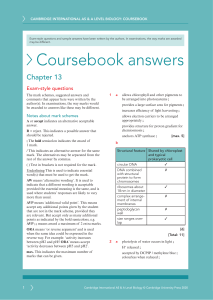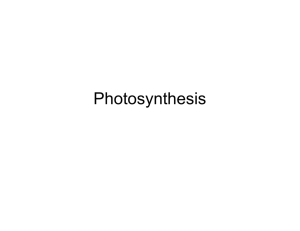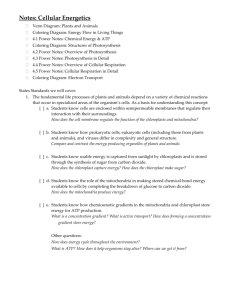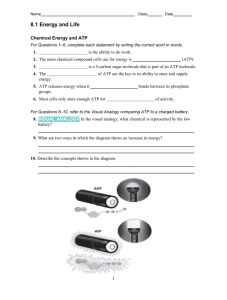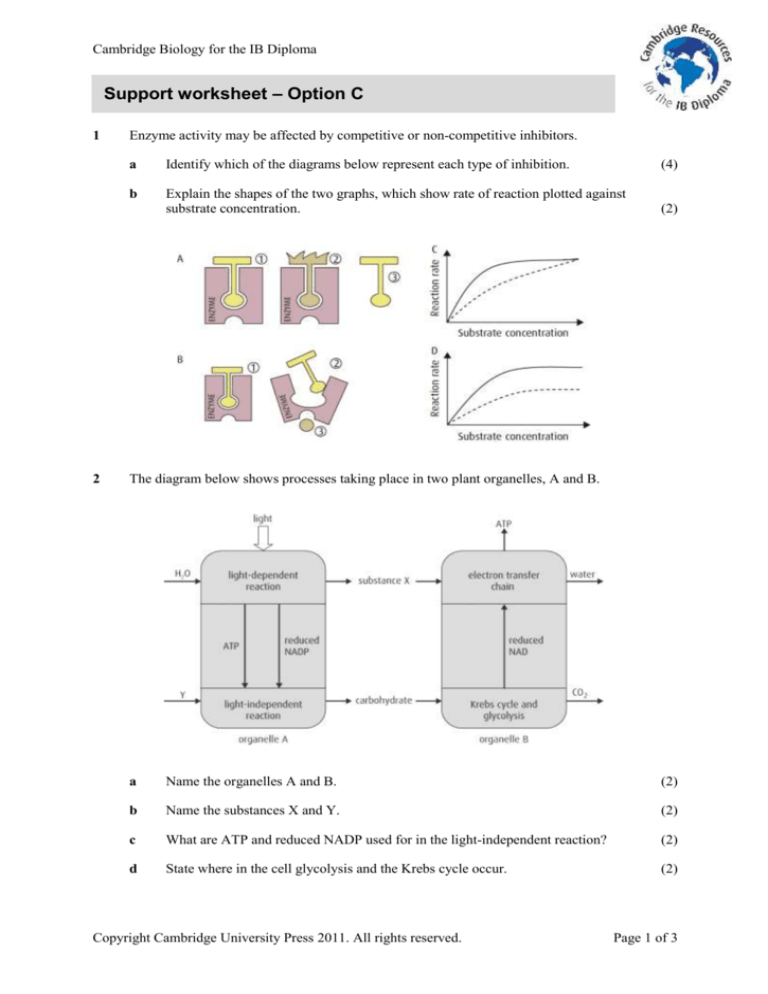
Cambridge Biology for the IB Diploma
Support worksheet – Option C
1
2
Enzyme activity may be affected by competitive or non-competitive inhibitors.
a
Identify which of the diagrams below represent each type of inhibition.
(4)
b
Explain the shapes of the two graphs, which show rate of reaction plotted against
substrate concentration.
(2)
The diagram below shows processes taking place in two plant organelles, A and B.
a
Name the organelles A and B.
(2)
b
Name the substances X and Y.
(2)
c
What are ATP and reduced NADP used for in the light-independent reaction?
(2)
d
State where in the cell glycolysis and the Krebs cycle occur.
(2)
Copyright Cambridge University Press 2011. All rights reserved.
Page 1 of 3
Cambridge Biology for the IB Diploma
3
Complete the following table, which compares the production of ATP in mitochondria
and in chloroplasts. Write ‘true’ or ‘false’ in the boxes to indicate which statements correctly
describe processes that occur in each organelle.
(10)
Process
Mitochondrion
Chloroplast
Photons excite electrons.
Electrons pass through carrier molecules.
Oxidative phosphorylation occurs.
ATP is produced from ADP and Pi.
Takes place in both light and darkness.
4
The graph shows the uptake and release of carbon dioxide by a green plant at different light
intensities.
a
The point P is known as the compensation point. Using the information on the graph,
explain what is happening at this point.
(2)
b
Describe the shape of the graph at point Q and explain what is happening in the cells. (2)
c
What are the products of the light-dependent reactions?
(2)
d
Why does the uptake of CO2 slow down at higher light intensities?
(1)
Copyright Cambridge University Press 2011. All rights reserved.
Page 2 of 3
Cambridge Biology for the IB Diploma
5
a
Why do plants need an effective root system in order to photosynthesize?
(1)
b
Copy and complete the following paragraph, which describes part of the process of
photosynthesis, by inserting the correct words in the spaces.
(8)
Chlorophyll a and chlorophyll b are both found in chloroplasts. Chlorophylls absorb
mainly _______________ and _______________ wavelengths of light. In the process of
cyclic photophosphorylation, light displaces an electron from a chlorophyll molecule.
This electron is returned to the chlorophyll via a series of _______________
_______________, each of which is at a lower energy level. _______________ is
synthesised as the electrons flow. _______________ is used in the light-independent
reactions, which occur in the _______________ of the chloroplast. In the process of noncyclic photophosphorylation, the electrons are combined with _______________
_______________, which are produced from the photolysis of _______________.
6
Chemiosmosis is a process that occurs in both mitochondria (during respiration) and
chloroplasts (during photosynthesis). Complete the table, which compares respiration and
photosynthesis.
Photosynthesis
(5)
Respiration
Place where H+
ions accumulate
between inner and outer membranes
of mitochondria
Source of H+ ions
hydrogen acceptors such as
NADH + H+
Source of energy
Use of ATP
formed
used in the stroma to reduce CO2
in light-independent reactions
Copyright Cambridge University Press 2011. All rights reserved.
Page 3 of 3






